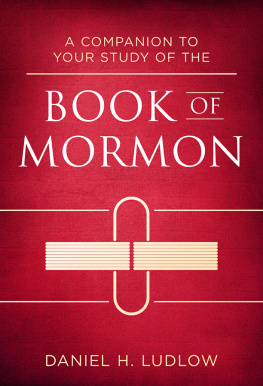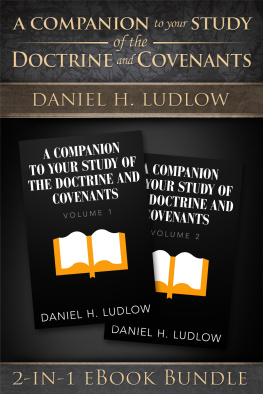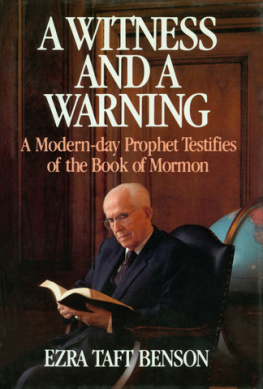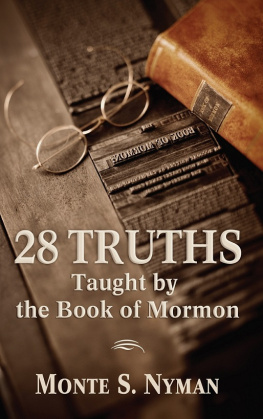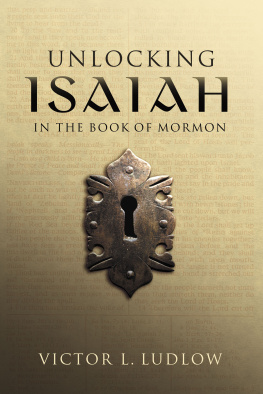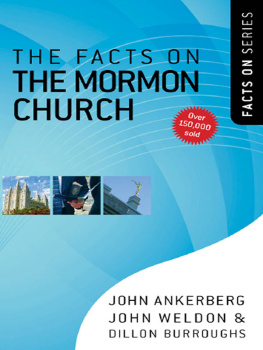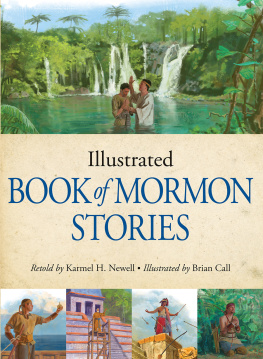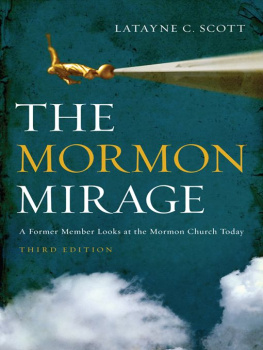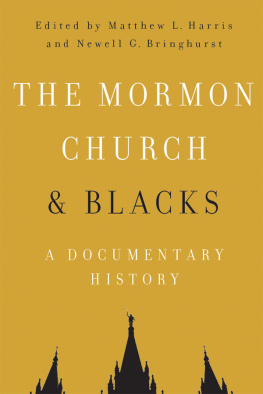PREFACE
A Companion to Your Study of the Book of Mormon is exactly what the name indicates: It is designed to assist the reader as he studies the Book of Mormon.
The Book of Mormon has been presented to the world with special credentials. The Three Witnesses testified that the Book of Mormon was "translated by the gift and power of God" and that "the work is true." (See "The Testimony of Three Witnesses," in the introductory pages of the Book of Mormon.) The Prophet Joseph Smith stated that the Book of Mormon was "the most correct of any book on earth, and the keystone of our religion, and a man would get nearer to God by abiding by its precepts than by any other book." (History of the Church, 4:461.) The Book of Mormon itself claims to contain the precious truths of the gospel of Jesus Christ, written in plainness and simplicity. Thus, the Book of Mormon is probably one of the easiest scriptures to read and understand.
The Book of Mormon was written originally by persons far removed from us today not only by time, but also by language and culture. Thus, some of their expressions, idioms, manners, and customs might be difficult for the person of the twentieth century to understand. Many of these difficult passages, however, have been explained by modern prophets. Other possible confusing sections have been illuminated through research and study of Latter-day Saint scholars. Still other obscure passages have been clarified by perceptive and discerning teachers. The major portion of the Companion is a compilation of explanations concerning the more challenging and difficult verses.
The Companion is much more than this, however. The first two chapters (pages 1-55) provides background information on the Prophet Joseph Smith and on the events associated with the coming forth of the Book of Mormon. The materials in this section are largely arranged chronologically.
The next chapter (pages 56-59) discusses the major sets of plates associated with the Book of Mormon and describes their relationship to each other and to the present printed scripture.
Another chapter (pages 60-64) provides historical background to the biblical world where the Book of Mormon first began, and still another (pages 65-85) gives a brief review of the secular history of the peoples of the Book of Mormon.
The longest and perhaps the most helpful section, however, is the one which provides additional information on selected verses and topics (pages 88-339). This material is arranged consecutively according to the books, chapters, and verses in the Book of Mormon. A year's course of study in the Book of Mormon is required of all freshmen and other new students at colleges and universities sponsored by the Church. Thus, tens of thousands of students have taken courses in the Book of Mormon at Brigham Young University, and their questions have been compiled over the years by some of the BYU faculty. Such questions were anticipated in the preparation of this Companion, and possible answers and explanations are included. Thus, after a reader has read a chapter in the Book of Mormon, he might want to refer to the Companion to see if any helps are included for any of the material in that chapter.
Still another section includes a series of appendixes that provide additional information related to the purposes and the messages of the Book of Mormon (pages 340-78).
The Companion concludes with some charts, maps, and diagrams that help to provide overview information on such diverse topics as the possible movements and locations of these people, the various sets of plates, and a chronological listing of Book of Mormon prophets and major political leaders.
The Companion is designed to be used only with the Book of Mormon, and its greatest value will be when it is used as a companion to the study of this sacred record. If the goals and purposes of the compiler and the publisher are achieved, then this volume will truly be a companion to your study of the Book of Mormon.
MOSIAH
Mosiah 1:1-2
The beginning of Mormon's abridged record
Note that the main story in the book of Mosiah is told in the third person rather than in the first person as was the custom in the earlier books of the Book of Mormon. The reason for this is that someone else is now telling the story, and that "someone else" is Mormon. With the beginning of the book of Mosiah we start our study of Mormon's abridgment of various books that had been written on the large plates of Nephi. (3 Nephi 5:8-12.) The book of Mosiah and the five books that followAlma, Helaman, 3 Nephi, 4 Nephi, and Mormonwere all abridged or condensed by Mormon from the large plates of Nephi, and these abridged versions were written by Mormon on the plates that bear his name, the plates of Mormon. These are the same plates that were given to Joseph Smith by the angel Moroni on September 22, 1827.
Mosiah 7:17
The temple in the land of Lehi-Nephi
This is the first reference to a temple in the land of Lehi-Nephi. The two earlier temples mentioned in the Book of Mormon were located in the land of Nephi (2 Nephi 5:16) and in the land of Zarahemla (Mosiah 1:18). No further information is provided in our present Book of Mormon concerning when or by whom this temple in the land of Lehi-Nephi was first constructed.
Mosiah 7:26
The prophet of the land who was killed
The prophet who is mentioned in this verse as having been killed because of the wickedness and abominations of the people is the prophet Abinadi. The teachings of Abinadi are found in Mosiah, chapters 11-17.
Mosiah 8:7-12
The land of destruction discovered by the scouts of Limhi
The evidences of destruction that were discovered by the forty-three scouts sent out by King Limhi are the remains of the great Jaredite civilization of which we will read in the book of Ether.
Mosiah 8:13-17
Definition of a "seer"
The word seer literally means one who sees: a see-er. Ammon says a seer is a person who has the right to use the "interpreters" or the Urim and Thummin. (Mosiah 8:13-17; see also Mosiah 28:10-16.) He states further: "a seer is a revelator and a prophet also; and a gift which is greater can no man have." (Mosiah 8:16.) Members of The Church of Jesus Christ of Latter-day Saints regularly sustain the members of the First Presidency, the Council of the Twelve Apostles, and the Patriarch to the Church as "Prophets, Seers, and Revelators."
Mosiah 9:1
The record of Zeniff
Chapters 9 and 10 of Mosiah are evidently taken verbatim from a record originally prepared by Zeniff. Note that these two chapters are written in the first person: "I, Zeniff," etc. Beginning with chapter 11, the account is written in the third person, although these materials also evidently come from the record of Zeniff.
Mosiah 9:9
The crops of the Nephites
Although the equivalent of the word corn is used in some Semitic languages to refer to various types of cereals, including wheat, Joseph Smith would probably translate it here so it would be clear to the understanding of his readers in the United States. Thus, the "corn" here is probably maize, which is frequently called corn in the Americas. It is not clear what crops are referred to by the titles of "neas" and "sheum."
Mosiah 10:6
The king of the Lamanites
Evidently the Lamanites have used the same procedure as the Nephites did in their early history of naming their kings after their earliest leader. Jacob 1:11 mentions that the kings who succeeded Nephi were known as "second Nephi, third Nephi, and so forth, according to the reigns of the kings." Thus it should not be too surprising to discover that the king of the Lamanites in approximately 178 B.C. was still known as "King Laman" (Mosiah 10:6), although the original leader after whom the king was named had lived some four hundred years before. Also, later in the Book of Mormon we discover that the son who succeeded this king is also known as Laman. (See Mosiah 24:3.)

